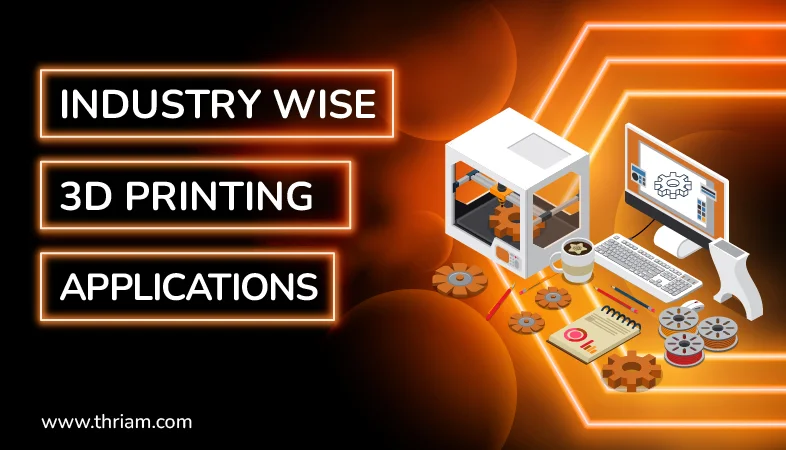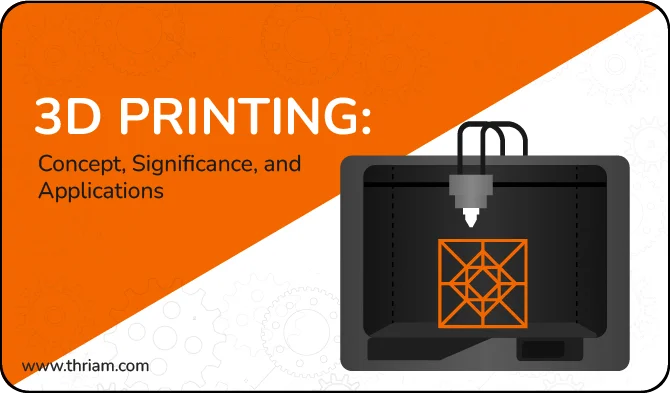Material Selection Made Easy: A Practical Approach to 3D Printing Materials

3D printing has revolutionized the manufacturing industry, enabling us to turn digital designs into physical objects with ease. However, achieving the desired results requires careful consideration of the material used for 3D printing.
What is 3D printing?
3D printing, also known as additive manufacturing, is a groundbreaking technology that has the potential to revolutionize the way we design and produce objects. It is a process of creating three-dimensional objects by gradually adding material layer by layer based on a digital design or model, bringing virtual concepts into the physical realm with incredible precision and detail.
In this blog, we will explore the factors that affect material selection for 3D printing projects and provide valuable tips to help you select the right material for your specific needs.
I. Understanding Different 3D Printing Materials
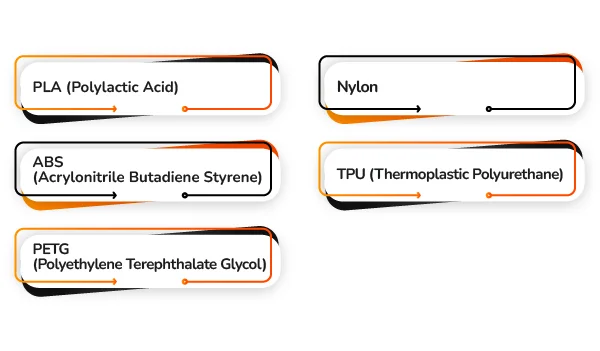
Before diving into the selection process, let's familiarize ourselves with some commonly used materials in 3D printing:
PLA (Polylactic Acid):
A biodegradable thermoplastic that is easy to print with and frequently used for rapid prototyping and low-stress applications.
ABS (Acrylonitrile Butadiene Styrene):
A durable and impact-resistant plastic often used for functional parts such as automotive components, toys, and electronics.
PETG (Polyethylene Terephthalate Glycol):
Similar to ABS but with superior durability and toughness, making it suitable for applications that require strength and flexibility.
Nylon:
Known for its strength, flexibility, and resistance to wear and abrasion, nylon is commonly used for functional and mechanical parts.
TPU (Thermoplastic Polyurethane):
A flexible and rubber-like material ideal for producing items such as phone cases, shoe soles, and prosthetics.
Others:
There are a plethora of other materials available, each with their own unique properties, like PC (Polycarbonate), PVA (Polyvinyl Alcohol), and more.
II. Factors to Consider when Selecting 3D Printing Materials
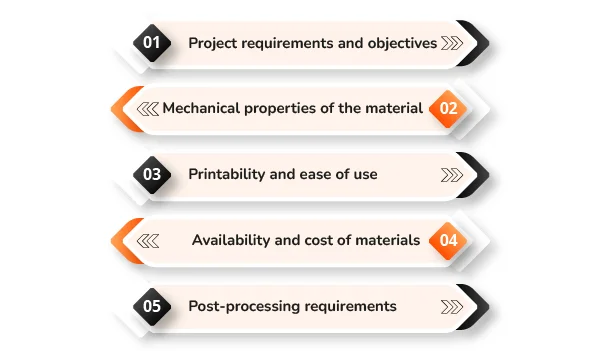
To ensure success in your 3D printing projects, it's crucial to consider the following factors when selecting materials:
- Project requirements and objectives: Evaluate the purpose, function, and desired characteristics of your project to determine the appropriate material properties, such as strength, flexibility, heat resistance, or transparency.
- Mechanical properties of the material: Consider factors like tensile strength, elongation at break, impact resistance, and modulus of elasticity to ensure the material can withstand the necessary loads and stresses.
- Printability and ease of use: Evaluate the material's compatibility with your 3D printer's specifications, such as nozzle temperature and bed adhesion requirements. Some materials might require specific settings, additional equipment, or post-processing steps.
- Availability and cost of materials: Consider the availability and cost of the material, as it may impact the feasibility of your project. While some materials may offer exceptional properties, they could be more expensive or harder to source.
- Post-processing requirements: Determine whether the material requires additional post-processing steps, such as sanding, painting, or applying a surface finish, to achieve the desired aesthetics or functionality.
III. Matching Materials to Project Applications
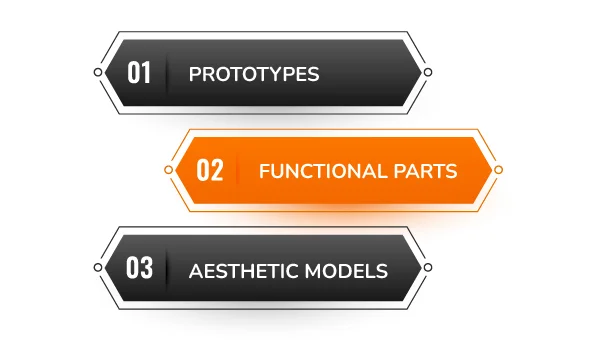
Different types of projects require specific materials to achieve the intended outcomes. Here are some material recommendations for common project applications:
Prototypes:
For rapid prototyping, PLA is often a popular choice due to its ease of use, low cost, and decent mechanical properties. However, if functional testing is required, materials like ABS or PETG might be more suitable due to their durability.
Functional Parts:
When creating functional parts that need to withstand mechanical stress, consider materials like ABS, PETG, or nylon for their strength and durability. These materials offer excellent mechanical properties and can withstand constant use.
Aesthetic Models:
For aesthetic models with fine details or smooth surfaces, materials like PLA or resin can achieve high-quality, visually appealing results. Resin printers often provide better detail and surface finish, but they require more specialized equipment.
IV. Tips for Selecting the Right Material
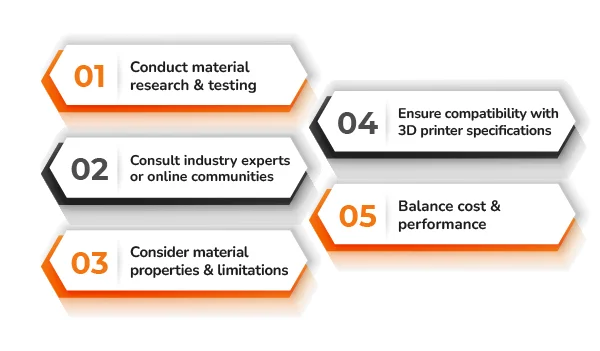
To assist you in the material selection process, here are some valuable tips to consider:
Conduct material research and testing:
Utilize online resources, material databases, and manufacturer specifications to gather information about different materials. Consider obtaining material samples or utilizing 3D printing services to test materials before committing to larger projects.
Consult industry experts or online communities:
Engage with professionals, 3D printing enthusiasts, and online communities to seek advice and learn from their experiences. They can provide valuable insights and recommendations based on their expertise.
Consider material properties and limitations:
Understand the strengths and weaknesses of different materials. Evaluate how they perform under specific conditions, such as temperature extremes or exposure to chemicals, to ensure compatibility with your project requirements.
Ensure compatibility with 3D printer specifications:
Check compatibility guides and review your 3D printer's specifications to ensure that the chosen material is suitable for your printer. Pay attention to parameters like nozzle temperature, bed adhesion techniques, and print speed.
Balance cost and performance:
Determine your budget and evaluate the cost of materials. Balance it with the desired performance and properties required for your project. While some materials may offer better performance, they could come at a higher cost.
V. Conclusion
Selecting the right material for your 3D printing projects is crucial to achieve desirable outcomes. By considering project requirements, material properties, printability, availability, and post-processing requirements, you can make an informed decision. Remember to conduct thorough research, consult experts, and test materials when necessary. With careful material selection, you can unlock the full potential of 3D printing and bring your designs to life.
Bonus content
Case Studies - Examples of Material Selection for Different 3D Printing Projects
To illustrate the impact of material selection, let's explore a few case studies:
- Case Study 1 - Creating a Functional Gear: When designing a gear that requires strength and resistance to wear, nylon might be the best choice due to its excellent mechanical properties and low friction. Using a brittle material like PLA would likely result in rapid failure.
- Case Study 2 - Designing a Prototyping Dummy: For rapid prototyping purposes, PLA can be a cost-effective material. Its ease of use and decent mechanical properties make it suitable for testing the form and fit of the prototype before moving on to more durable materials.
